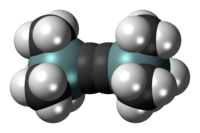Bis(trimethylsilyl)acetylene
 |
|
 |
|
| Names | |
|---|---|
|
IUPAC name
Bis(trimethylsilyl)acetylene
|
|
| Other names
BTMSA
|
|
| Identifiers | |
|
3D model (Jmol)
|
|
| ChemSpider | |
| ECHA InfoCard | 100.035.141 |
|
PubChem CID
|
|
|
|
|
|
| Properties | |
| C8H18Si2 | |
| Molar mass | 170.40 g·mol−1 |
| Appearance | Colorless to white Liquid |
| Density | 0.791 g/cm3 |
| Melting point | 26 °C (79 °F; 299 K) |
| Boiling point | 134.6 ± 8.0 °C |
| 0.031 g/L | |
| Hazards | |
| Main hazards | Flammable, Irritant |
|
Except where otherwise noted, data are given for materials in their standard state (at 25 °C [77 °F], 100 kPa).
|
|
|
|
|
| Infobox references | |
Bis(trimethylsilyl)acetylene (BTMSA) is an organosilicon compound with the formula C2(Si(CH3)3)2. It is a colorless liquid that is soluble in organic solvents. This compound is used as a surrogate for acetylene.
BTMSA is prepared by treating acetylene with butyl lithium followed by addition of chlorotrimethylsilane:
BTMSA is used as a nucleophile in Friedel-Crafts type acylations and alkylations and a precursor to lithium trimethylsilylacetylide. The TMS groups can be removed with tetra-n-butylammonium fluoride (TBAF) and replaced with protons. BTMSA is also a useful reagent in cycloaddition reactions. Illustrating its versatility, BTMSA was used in a concise total synthesis of (±)-estrone. A key step in this synthesis was the formation of the steroidal skeleton, catalyzed by CpCo(CO)2.
BTMSA also serves as a ligand in organometallic chemistry. For example, it forms stable adducts with metallocenes.
BTMSA is also used in the total synthesis of epibatidine (and analogs), and also in the synthesis of iclaprim.
...
Wikipedia
